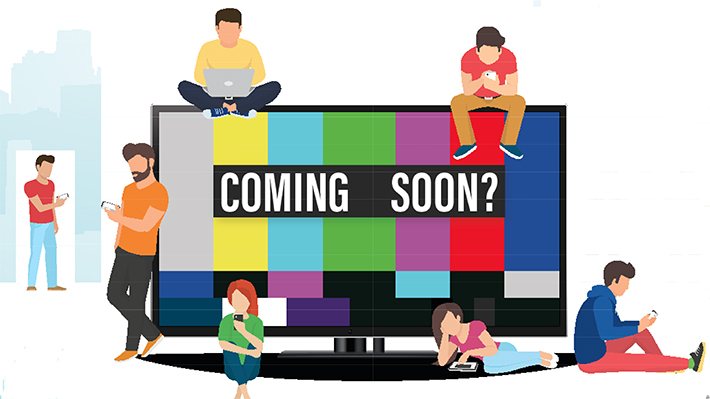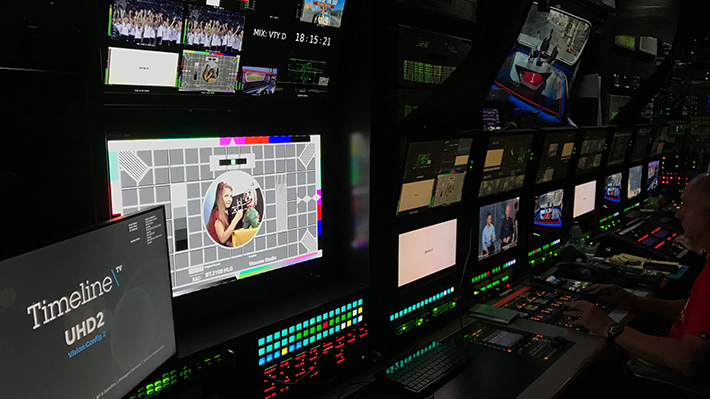O 4K, Wherefore Art Thou?

Guardians of the Galaxy Vol. 2, 8K.
What’s more, these costs cannot easily be passed on to the consumer who is reluctant to pay more for content which may be perceived as only a moderately better resolution.
VOD streaming services have fewer of these inhibitors, and indeed Netflix, Amazon Prime, Hulu and Apple are now commissioning most of their originals in 4K. Even here it has proven difficult to entice subscribers to pay an additional fee to receive a show in 4K. When, last year, Apple made shows on iTunes the same price regardless of resolution, it forced rivals like Amazon to revise their fees downward too.
Netflix is about to test these waters further. It is trialling an Ultra tier of its service which will charge select subscribers €16.99 a month to view content in UHD and HDR across up to four screens.
Experimental
Despite the enthusiasm of a few big companies, 4K live streaming is still at the experimental and promotional stage of
its evolution.
At the FIFA World Cup, Telestream (which makes products for video capture, encoding and transcoding) told FEED that it is working with various broadcasters, producing some 60+ channels of live HD streaming and just one 4K stream. This 4K stream is being driven largely through a promotional agreement with a consumer electronics manufacturer.
 Still, others take a more optimistic approach. Olivier Karra, director OTT and IPTV solutions at media processing solutions developer Harmonic, believes 4K live OTT streaming is breaking through.
“Constraints are being unlocked, or at least diminished, one after the other even if sourcing content for a linear channel and HDR compatibility remains challenging,” he says.
Certainly, live 4K OTT will increase: anything that service providers do in the VOD space is likely to be emulated in live applications at some point. It’s just a matter of when the technology catches up.
“If you look at the bitrate variance that you produce for VOD content, it’s standard to have H.265 4K variants at the upper end of that spectrum – I would expect this to become the case with live,” says Telestream’s CTO Shawn Carnahan.
As always the nub of the issue today is cost – it is expensive. “While VOD delivery of 4K content is more expensive (than HD), it’s not that much more expensive,” explains Carnahan. “However, encoding live 4K streams requires significant computing resources (at least double). Combine this with the much higher delivery bandwidth costs and 4K live streaming is substantially more expensive.
Limited bandwidth
It is limited bandwidth speeds to the home, rather than a failure of service providers to optimise the content delivery network, which is also inhibiting 4K live streaming.
“The reality is that you won’t get anywhere near the same efficiency out of 4K encoding in a live application as you will for VOD,” says Carnahan. “The bandwidths required to deliver 4K live are pretty high – prohibitively high for most clients. We’re talking about 18Mbps minimum and that’s tough to sustain at the consumer level.
“It’s a catch-up game. As more consumers have fibre in the home with 100 Mbps sustained connections, then it’s not so much of a problem.”
Amazon recommends at least 15Mbps, while Netflix advises 25Mbps. But if other devices at home will be occupying your bandwidth, 15 or 25Mbps alone won’t suffice. Latest figures from UK communications regulator Ofcom, based on a survey from November, show the average UK broadband connection is 46.2Mbps, compared to 36.2Mbps the previous year.
Ofcom also broke the data down by connection type. For example, at peak times fibre averaged 33.5Mbps and cable (Virgin Media) achieved 99.7Mbps. Anyone in the UK with an ADSL connection is still suffering from 9.6Mbps download speeds.
However, there’s a clear digital divide between rural and urban locations, with more than half of broadband customers in rural areas receiving an average download speed of less than 10Mbps, compared to 21% for the whole of the UK and 16% in urban areas.
Under current plans, the UK government is aiming for 98% coverage for superfast (24Mbps+) broadband, and an assurance that the remaining 2% can get at least 10 Mbps on request.
“Most countries in western Europe have a fairly good penetration of high connectivity into the home, but that doesn’t mean consistency of delivery over the internet isn’t a challenge,” says Ian Munford, the Director of Product Marketing and Enablement for Media Solutions, at content delivery network provider Akamai. “Many devices are competing for bandwidth in the home.”
Tech solutions
The industry is creating some fantastic encoding efficiencies that make 4K VOD streaming viable by lowering the bitrate. Harmonic’s EyeQ Content Aware Encoding technology is claiming bandwidth savings for UHD HEVC up to 40%, for example.
With VOD, the consumer doesn’t mind if it takes another 10-15 seconds to buffer up at the start of a program. But any lag with live becomes a real consumer bugbear. It’s considered pretty good just now to keep latency within the 10-12 second range for live OTT. Harmonic says its technology has already demonstrated end-to-end UHD HDR workflows with latency below six seconds.
Realistically though, latency has little to do with encoding or bandwidth. Even if you have reliable 40Mbps connections for 4K streaming latency, it is the segmentation and cache levels throughout the CDN which are responsible for 95% of all latency.
“You can try to optimise that, but it gets much more difficult with higher bitrates to push the envelope,” says Carnahan.
Harmonic’s Karra agrees, “In order to maintain a premium video quality and a quality of experience, content owners do not want to see their content being ‘squeezed’ too much. A balance needs to be found.”
The introduction of high dynamic range, which is believed to make a greater perceptual difference to image quality than upping the number of pixels, adds more complexity to the mix.
It also consumes about 10% to 15% more bandwidth than encoding a standard dynamic range UHD signal, reckons Harmonic. And that’s before higher frame rates – useful for sports, and nigh on essential for computer gaming – are taken into consideration.
Alternatives
The BBC’s live UHD HDR streaming experiment during the World Cup required viewers to have at least 40 megabits into the home to receive the full 3840 pixel resolution running at 50 frames-per-second.
A bigger challenge was the support of mixed HDR combinations throughout the distribution chain. The BBC wanted to stream an HDR signal that would work on the widest range of displays possible, and not just the latest HDR-outfitted devices.
Yet the host FIFA signal was produced with an arguably more premium experience in mind.
Still, others take a more optimistic approach. Olivier Karra, director OTT and IPTV solutions at media processing solutions developer Harmonic, believes 4K live OTT streaming is breaking through.
“Constraints are being unlocked, or at least diminished, one after the other even if sourcing content for a linear channel and HDR compatibility remains challenging,” he says.
Certainly, live 4K OTT will increase: anything that service providers do in the VOD space is likely to be emulated in live applications at some point. It’s just a matter of when the technology catches up.
“If you look at the bitrate variance that you produce for VOD content, it’s standard to have H.265 4K variants at the upper end of that spectrum – I would expect this to become the case with live,” says Telestream’s CTO Shawn Carnahan.
As always the nub of the issue today is cost – it is expensive. “While VOD delivery of 4K content is more expensive (than HD), it’s not that much more expensive,” explains Carnahan. “However, encoding live 4K streams requires significant computing resources (at least double). Combine this with the much higher delivery bandwidth costs and 4K live streaming is substantially more expensive.
Limited bandwidth
It is limited bandwidth speeds to the home, rather than a failure of service providers to optimise the content delivery network, which is also inhibiting 4K live streaming.
“The reality is that you won’t get anywhere near the same efficiency out of 4K encoding in a live application as you will for VOD,” says Carnahan. “The bandwidths required to deliver 4K live are pretty high – prohibitively high for most clients. We’re talking about 18Mbps minimum and that’s tough to sustain at the consumer level.
“It’s a catch-up game. As more consumers have fibre in the home with 100 Mbps sustained connections, then it’s not so much of a problem.”
Amazon recommends at least 15Mbps, while Netflix advises 25Mbps. But if other devices at home will be occupying your bandwidth, 15 or 25Mbps alone won’t suffice. Latest figures from UK communications regulator Ofcom, based on a survey from November, show the average UK broadband connection is 46.2Mbps, compared to 36.2Mbps the previous year.
Ofcom also broke the data down by connection type. For example, at peak times fibre averaged 33.5Mbps and cable (Virgin Media) achieved 99.7Mbps. Anyone in the UK with an ADSL connection is still suffering from 9.6Mbps download speeds.
However, there’s a clear digital divide between rural and urban locations, with more than half of broadband customers in rural areas receiving an average download speed of less than 10Mbps, compared to 21% for the whole of the UK and 16% in urban areas.
Under current plans, the UK government is aiming for 98% coverage for superfast (24Mbps+) broadband, and an assurance that the remaining 2% can get at least 10 Mbps on request.
“Most countries in western Europe have a fairly good penetration of high connectivity into the home, but that doesn’t mean consistency of delivery over the internet isn’t a challenge,” says Ian Munford, the Director of Product Marketing and Enablement for Media Solutions, at content delivery network provider Akamai. “Many devices are competing for bandwidth in the home.”
Tech solutions
The industry is creating some fantastic encoding efficiencies that make 4K VOD streaming viable by lowering the bitrate. Harmonic’s EyeQ Content Aware Encoding technology is claiming bandwidth savings for UHD HEVC up to 40%, for example.
With VOD, the consumer doesn’t mind if it takes another 10-15 seconds to buffer up at the start of a program. But any lag with live becomes a real consumer bugbear. It’s considered pretty good just now to keep latency within the 10-12 second range for live OTT. Harmonic says its technology has already demonstrated end-to-end UHD HDR workflows with latency below six seconds.
Realistically though, latency has little to do with encoding or bandwidth. Even if you have reliable 40Mbps connections for 4K streaming latency, it is the segmentation and cache levels throughout the CDN which are responsible for 95% of all latency.
“You can try to optimise that, but it gets much more difficult with higher bitrates to push the envelope,” says Carnahan.
Harmonic’s Karra agrees, “In order to maintain a premium video quality and a quality of experience, content owners do not want to see their content being ‘squeezed’ too much. A balance needs to be found.”
The introduction of high dynamic range, which is believed to make a greater perceptual difference to image quality than upping the number of pixels, adds more complexity to the mix.
It also consumes about 10% to 15% more bandwidth than encoding a standard dynamic range UHD signal, reckons Harmonic. And that’s before higher frame rates – useful for sports, and nigh on essential for computer gaming – are taken into consideration.
Alternatives
The BBC’s live UHD HDR streaming experiment during the World Cup required viewers to have at least 40 megabits into the home to receive the full 3840 pixel resolution running at 50 frames-per-second.
A bigger challenge was the support of mixed HDR combinations throughout the distribution chain. The BBC wanted to stream an HDR signal that would work on the widest range of displays possible, and not just the latest HDR-outfitted devices.
Yet the host FIFA signal was produced with an arguably more premium experience in mind.
 “Implementing universal HDR support would be ideal but is not economically viable,” says Karra. “This is why chipset, decoding devices and TV manufacturers are generally only implementing a subset with specific flavours. Even when a single HDR type is being used, switching back and forth to UHD SDR or HD can be challenging.”
Harmonic says it can solve this pain point by enabling automatic HDR conversions if necessary and thereby allowing service providers to normalise their distribution formats, despite the diversity of content formats.
Then there’s the issue of whether 4K content works for smaller screens. You need to use either a connected TV or an OTT set-top box connected to the TV to truly benefit from the video quality increase in a perceptible manner. Yet the worldwide trend is toward increased mobile device viewing.
In Akamai’s analysis of what constitutes optimal stream quality for long-form viewing, it found that 1.5Mbps to 2Mbps was more than sufficient for viewing on an iPhone. “Your eyes can’t determine better perceptual quality beyond that,” says Munford.
With live, event-based streaming, higher framerate is a positive, but it’s a must when it comes to eSports. “A 60p experience on mobile is arguably better than a 4K lower framerate experience,” says Carnahan. “The resolution does not necessarily make the experience more compelling, whereas higher framerates can.”
Even BT Sport, which is investing in a future 5G network, understands that 4K UHD is not a good use of bits or bandwidth to mobile.
“Going forward, our baseline for live events streamed to mobile will be HD 1080p, 60 frames a second,” says Matt Stagg, BT Sport’s director of mobile strategy.
Still an HD future?
Even content producers who are at the cutting edge of production are not yet swayed that the benefits of cost and convenience of working in HD have been overtaken by those of 4K.
“The whole idea of resolution for a filmmaker is a bit of a myth,” says Robin Dimbleby, a natural history producer who has filmed lions and monkeys for Sky wildlife shows and who is currently filming in Indonesia for NHNZ. “The most important thing is for your story to come through properly. We don’t want to get into a resolution arms race which is why we do a lot of HD sequences still within our quota [of HD material acceptable for Sky’s UHD output].
“Who has a 4K TV? Everyone is still watching in HD.”]]>
“Implementing universal HDR support would be ideal but is not economically viable,” says Karra. “This is why chipset, decoding devices and TV manufacturers are generally only implementing a subset with specific flavours. Even when a single HDR type is being used, switching back and forth to UHD SDR or HD can be challenging.”
Harmonic says it can solve this pain point by enabling automatic HDR conversions if necessary and thereby allowing service providers to normalise their distribution formats, despite the diversity of content formats.
Then there’s the issue of whether 4K content works for smaller screens. You need to use either a connected TV or an OTT set-top box connected to the TV to truly benefit from the video quality increase in a perceptible manner. Yet the worldwide trend is toward increased mobile device viewing.
In Akamai’s analysis of what constitutes optimal stream quality for long-form viewing, it found that 1.5Mbps to 2Mbps was more than sufficient for viewing on an iPhone. “Your eyes can’t determine better perceptual quality beyond that,” says Munford.
With live, event-based streaming, higher framerate is a positive, but it’s a must when it comes to eSports. “A 60p experience on mobile is arguably better than a 4K lower framerate experience,” says Carnahan. “The resolution does not necessarily make the experience more compelling, whereas higher framerates can.”
Even BT Sport, which is investing in a future 5G network, understands that 4K UHD is not a good use of bits or bandwidth to mobile.
“Going forward, our baseline for live events streamed to mobile will be HD 1080p, 60 frames a second,” says Matt Stagg, BT Sport’s director of mobile strategy.
Still an HD future?
Even content producers who are at the cutting edge of production are not yet swayed that the benefits of cost and convenience of working in HD have been overtaken by those of 4K.
“The whole idea of resolution for a filmmaker is a bit of a myth,” says Robin Dimbleby, a natural history producer who has filmed lions and monkeys for Sky wildlife shows and who is currently filming in Indonesia for NHNZ. “The most important thing is for your story to come through properly. We don’t want to get into a resolution arms race which is why we do a lot of HD sequences still within our quota [of HD material acceptable for Sky’s UHD output].
“Who has a 4K TV? Everyone is still watching in HD.”]]>










